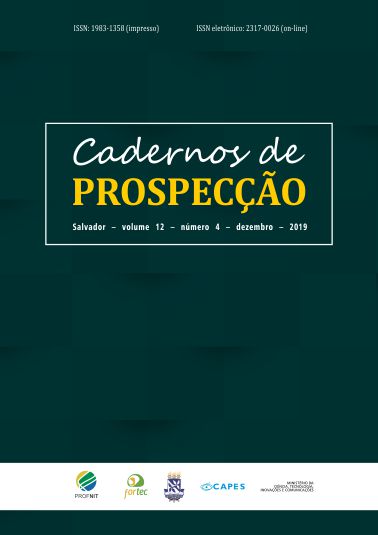Editorial
DOI:
https://doi.org/10.9771/cp.v12i4.34838Abstract
The Technological Innovation Law (Law n. 10.973/2004), regulated by Decree n. 5,563/2005, highlights the creation of Technological Innovation Centers (NIT) as something important for the technologies developed in Scientific, Technological (ICT) and innovative Institutions to reach the market. Thus, the NITs have, in their attributions, the responsibility of transferring these technologies to companies that will transform them into products and make them available on the market. The new Legal Framework, established by Law n. 13.243/2016 and regulated by Federal Decree no. 9,283/2018, sought to create a more favorable environment for the interaction between companies and public ICTs by reformulating the Innovation Law, among other laws that interact for the exercise of innovation.Even so, even with the regulatory apparatus, NITs have found it difficult to carry out this transfer due to several factors, such as lack of qualified personnel and legal certainty required for the business aspects involved in technology transfer, often restricting themselves to only to the protection of intellectual property. Technology transfer, in general, refers to the transfer of scientific knowledge generated in universities and research centers to companies. This process involves the transformation of laboratory bench research into technology that will be produced on an industrial scale. When the transferred knowledge surpasses, improves or perfects the state of the art (which is the technology already accessible to the public) and the market is successful, there is a technological innovation.
“1) facilitate the commercialization of research results to be made available to society; 2) reward, retain and recruit academic talent; 3) promote more relationships with the manufacturing industry; and 4) generate revenue and promote economic growth”. However, for there to be an expansion of Technology Transfer – University – Enterprise (TTUE), a solid national policy is needed to support the dissemination of IP and foster the interface between universities, government and the productive sector. In Brazil, technology transfer has been one of the major bottlenecks in the innovation process, especially with regard to financial and technical resources for closing the innovation cycle. Still, in this context of the activities of the NIT, the new regulation, in its article 16, included in its attributions that they must “[...] develop studies of technological prospection and competitive intelligence in the field of intellectual property, in order to guide ICT's innovation actions”. Scientific and technological prospecting makes it possible to evaluate in quantity, quality and in an adequate time the information about a topic, so that, through competitive intelligence techniques, the manager can make a decision. Therefore, it is a key factor that can serve both for the development of new technologies and to serve as a requirement for the NIT in the protection of new products and processes, as well as for defining the maintenance of assets that are on the ICT “shelf”. The prospection presents a variety of methodologies organized by some authors in three main groups, namely: Monitoring (Assessment), Vision (Foresight) and Forecasting (Forecasting), the latter being the realization of projections based on historical information and in trend modeling.
Since its creation, Cadernos de Prospecção has brought a great deal of interaction with the laws and also updated content with the theme. In this volume, the Magazine addresses some research of great value for the performance of NITs in the country, in its three lines: Intellectual Property, Innovation and Development; Technological Prospections of Specific Subjects and Geographical Indications, In Intellectual Property, Innovation and Development, research comes back and for experiences in technology transfer and for monitoring innovation in the country. In the Technological Prospects of Specific Subjects line, prospective studies are presented on various technologies, ranging from the environment to health. And, last but not least, there is a study on Geographical Indication as a basis for other protection processes in this area. Reading the content presented in this volume will enrich knowledge on the topics addressed, in addition to permeating improvements in analysis techniques and discussing how they can be used in different areas of knowledge, given that intellectual property and innovation are multidisciplinary disciplines. . I wish you all an excellent read! Noélia Lúcia Simões Falcão Master in Intellectual Property and Innovation (INPI) NIT-INPA Coordinator The Association of University Technology Managers (AUTM) points out four goals for academic technology transfer:
Downloads
Download data is not yet available.
Downloads
Published
2019-12-28
How to Cite
Falcão, N. L. S. (2019). Editorial. Cadernos De Prospecção, 12(4), 717. https://doi.org/10.9771/cp.v12i4.34838
Issue
Section
Editorial
License
Copyright (c) 2019 Cadernos de Prospecção

This work is licensed under a Creative Commons Attribution-NonCommercial 4.0 International License.
O autor declara que: - Todos os autores foram nomeados. - Está submetendo o manuscrito com o consentimento dos outros autores. - Caso o trabalho submetido tiver sido contratado por algum empregador, tem o consentimento do referido empregador. - Os autores estão cientes de que é condição de publicação que os manuscritos submetidos a esta revista não tenham sido publicados anteriormente e não sejam submetidos ou publicados simultaneamente em outro periódico sem prévia autorização do Conselho Editorial. - Os autores concordam que o seu artigo ou parte dele possa ser distribuído e/ou reproduzido por qualquer forma, incluindo traduções, desde que sejam citados de modo completo esta revista e os autores do manuscrito. - Revista Cadernos de Prospecção está licenciado com uma Licença Creative Commons Attribution 4.0. Esta licença permite que outros remixem, adaptem e criem a partir do seu trabalho para fins não comerciais, e embora os novos trabalhos tenham de lhe atribuir o devido crédito e não possam ser usados para fins comerciais, os usuários não têm de licenciar esses trabalhos derivados sob os mesmos termos.
Este obra está licenciado com uma Licença Creative Commons Atribuição 4.0 Internacional.





